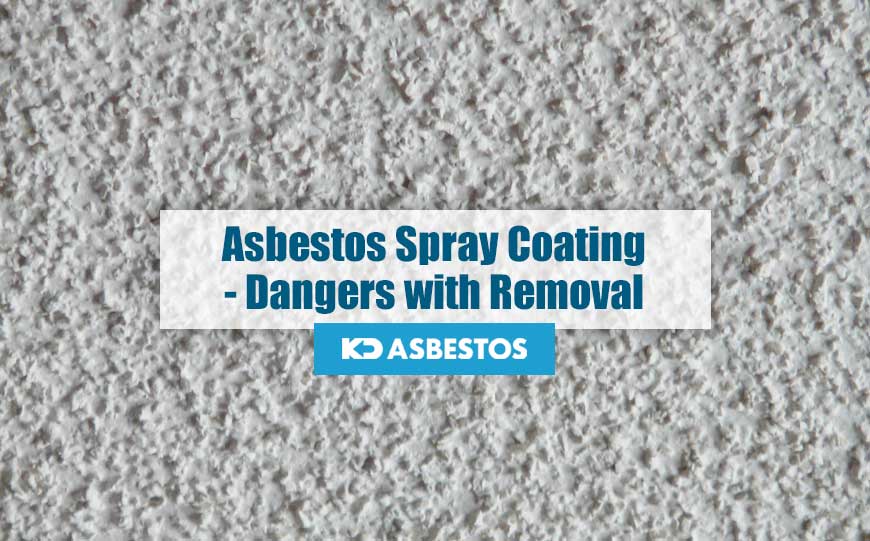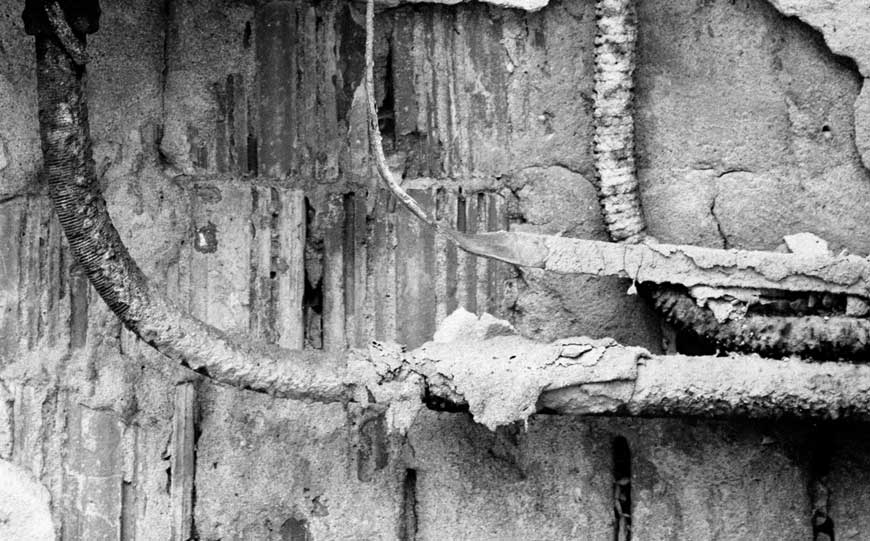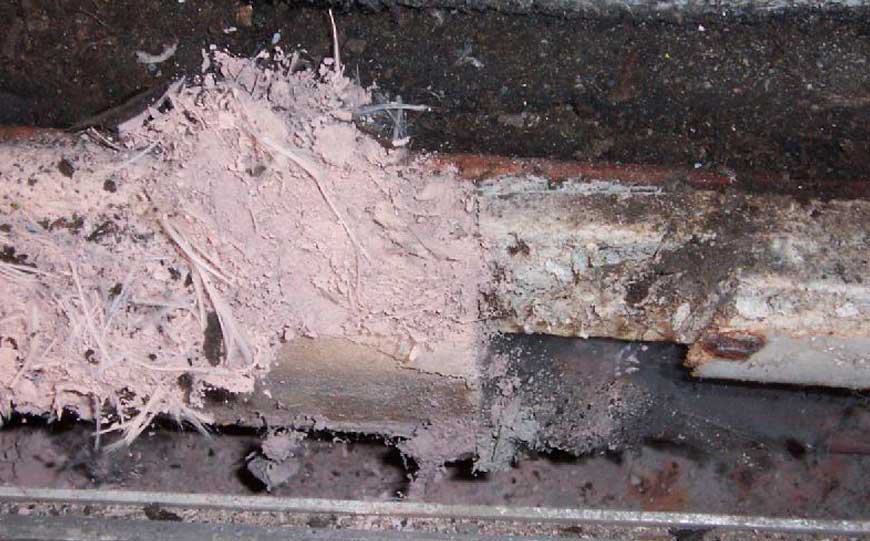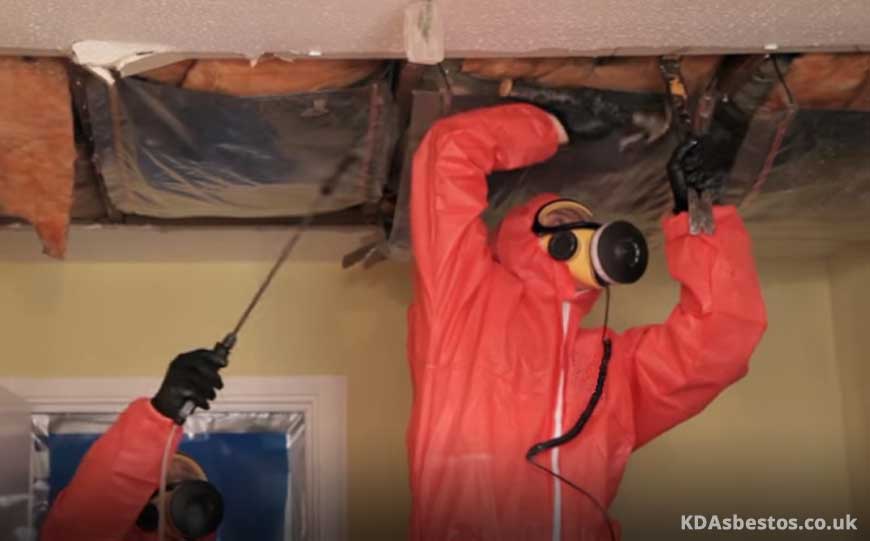
Asbestos spray coating was very popular particularly between the 1950s and 1970s.
They started to be phased out in the 1970s when the health dangers associated with this material started to become known.
Such coatings were also referred to as flock or limpet.
They were sprayed under high or low pressure, and the mixture contained various asbestos fibres added to adhesives and resins.
Often the asbestos fibres were mixed with Portland cement binder so that they could stick together well, and the fibres can actually be seen in such coatings.
Asbestos spray coatings are unfortunately still present in some older buildings.
Such coatings were applied for a variety of reasons.
They are dangerous since the asbestos content in such coatings is considerably high, even going up to around 85%.
Table of Contents
Where Were Asbestos Spray Coatings Used?

Asbestos spray coatings were used on ceilings and applied to beams, mainly for fire protection purposes.
Many factories and warehouses had asbestos spray coatings applied on their ceilings.
The coatings were also helpful for thermal insulation.
These coatings also helped with soundproofing and acoustic insulation, and so they were used in theatres and studios too.
Asbestos spray coatings were also applied to car park ceilings, as well as structural elements to make them stronger, especially when there were apartments or hotels built over them.
How Asbestos Spray Coating Was Applied
Back then, asbestos spray coatings were applied in a very dangerous manner.
The workers did not even wear protective gear, and often ended up being exposed in an extreme manner.
This was also due to the fact that the coatings were applied by means of a large sprayer and simply sprayed directly onto the ceilings.
However, there was no way to ensure that it did not hit any other elements in the vicinity.
These could include the floors beneath, any windows, cavities and surrounding walls.
As a result, in most cases the asbestos spray simply ended up on anything else that was in close vicinity.
What Does Asbestos Spray Coating Look Like?

Asbestos spray coating is generally white or grey in colour.
Such coatings typically have a rather rough surface.
In some cases it may have been painted over and so this rough texture may not be that visible.
Only a thorough asbestos survey will correctly determine if any hazardous material is present.
How Dangerous is Asbestos Spray Coating?
It is dangerous to remove asbestos spray coatings, mainly because as noted earlier it has a high asbestos content.
Moreover, since it was applied rather haphazardly simply by spraying, most likely it ended up on various other surface areas.
It is also important to note that such coatings are easily damaged.
So the level of friability is considerably high, making its removal extremely dangerous.
Is Asbestos Spray Coating Dangerous or Difficult to Remove?

Asbestos spray coatings are probably one of the worst asbestos containing materials to remove.
Besides being dangerous due to the high asbestos content, it is also prone to breaking up easily.
Even a very small disturbance could easily end up releasing a lot of asbestos fibres into the air.
Needless to say, the asbestos removal process needs to be carried out by a professional.
Workers will need to be experienced and wear suitable PPE.
How is Asbestos Spray Coating Removed?
Removing asbestos spray coatings is a job that definitely needs to be left in the hands of a licensed asbestos contractor.
A licensed asbestos contractor will have the expertise, as well as the tools required for such a dangerous job.
The whole area where the process will be carried out will need to be enclosed and well prepared.
An injection suppression method is used to remove asbestos spray coatings.
The injection needle will saturate the spray coating throughout, going right through to the surface level.
All the surface areas will need to be kept wet as even if a small part is left dry, asbestos fibres could become airborne, which is very dangerous due to the high asbestos content.
Having said that, it is important to be careful as the asbestos coating is not too wet as otherwise it will be rather difficult to handle if it gets slurry.
Clearly the process is a very delicate one, and even a minor error or mishandling could result in serious repercussions.
The asbestos removal team who will be handling this job will need to make sure that they carefully examine the structure of the building, as well as the surface area that the coating was applied to.
It is also important to take into account any future plans the client might have for the building in question.
To be completely safe is difficult in such a situation, as even if the asbestos removal process is applied rigorously and professionally, there is often no way to guarantee that all the area will be completely clean.
Some areas of the building might never be completely safe unless demolition works are carried out.
It is important to point out that there is a considerable difference between the scraping of a smooth, flat concrete surface, and one involving pitted concrete.
In the latter case, there are going to be several gaps, and consequently the asbestos spray would have easily gone in between.
The type of surface and how smooth it is will have an impact on the whole removal process, both in terms of its costs as well as the amount of time required to carry out the process.
Conclusion
As we’ve outlined, it’s clear asbestos spray coatings are extremely dangerous to remove.
Considering the hazards involved, and the fact that even if the process were to be applied very carefully and rigorously by contacting a professional contractor, there’s still risks thereafter.
As a result, one may wish to consider the plausibility of removing asbestos spray coatings versus the complete demolition of such a contaminated building.
Besides the need to manage the material very carefully even in the future, the costs of removal and refurbishment will be considerably high.
Hence it is important to think ahead and make such an appropriate decision.